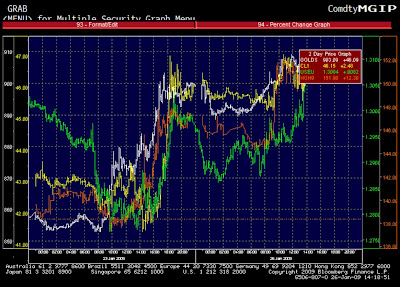This is the key issue for asset allocation ... We started to focus on this issue in
the previous post, pointing to the discussions at
Bronte Capital and
Cassandra Does Tokyo.
Here we quote Joachim
Fels and
Spyros Andreopoulos, European economists at Morgan Stanley, discussing the
"Could Hyperinflation Happen Again?" at the Global Economic Forum of Morgan Stanley:
According to Philip Cagan’s (1956) classical definition, hyperinflation is an episode where the inflation rate exceeds 50% per month. The historical examples of hyperinflation mostly occurred in the 1920s, when Austria, Germany, Hungary, Poland and Russia experienced galloping price increases. For example, Germany in 1923 recorded an astronomical inflation rate of 3.25 million percent in a single month. Since the 1950s, hyperinflations have been confined to developing and transition economies. Some recent examples include Argentina (1989-90), Bolivia (1984-85), Brazil (1989-90), Peru (1990), Ukraine (1991-94) and Zimbabwe in the past several years.
The root cause of hyperinflation is excessive money supply growth, usually caused by governments instructing their central banks to help finance expenditures through rapid money creation. Hyperinflations have mostly occurred in a context of political instability, adverse economic shocks and chronically high fiscal deficits. Hyperinflationary episodes are characterised by a general loss of confidence in the value of money, a flight into real assets and hard currencies, a surge in barter trade, and a shrinkage of financial intermediation and thus of the banking system.
An important empirical feature of hyperinflations is the high correlation of money supply growth and inflation rates. Money growth and inflation rates are also highly correlated in milder versions of high inflation episodes. Past bouts of high inflation in the UK, Italy, New Zealand and Mexico were preceded and accompanied by high growth rates of the money supply.
It is important to note that in low-inflation and low-monetary growth environments, the relationship between money growth and prices is much weaker or altogether non-existent. Average money growth rates have varied substantially between countries that have experienced relatively low (single-digit) inflation rates. However, countries with sustained high money growth rates have also experienced sustained high inflation.
Against this backdrop, could hyperinflation or high inflation happen again? Possibly yes, under certain circumstances.
First, the rapid expansion of the monetary base that the Fed, the ECB, the Bank of England and others have engineered in the last several months would have to continue and, importantly, would have to feed into a more rapid and sustained expansion of money in the hands of the general public.
Money supply M1 (consisting of currency in circulation and sight/checking deposits by non-banks) has gained momentum recently, especially in the US. We will be watching closely how this measure of money will evolve in the coming months.
Second, governments would have to face difficulties in financing rapidly rising expenditures on the various stimulus and bailout packages through taxes and selling bonds to the general public. In such circumstances, political pressures on central banks to monetise government spending would probably rise. This could be done through central bank loans to the government, central bank buying of government bonds at auction, outright unsterilised purchases of government bonds in the open market or additional lending to banks against government collateral.
Last, but not least, a combination of sustained monetary growth and high fiscal deficits would have to undermine the general public’s confidence in both the government’s ability to service the debt without taking resort to the printing press, and in the central bank’s ability or willingness to resist such pressures. A sudden surge in inflation expectations on the back of such a loss in confidence would induce people to reduce their deposits and cash holdings and pile into real assets. The velocity of money and inflation would rise, and the government/central bank would have to keep printing ever more money to finance government spending.
Clearly, this is an extreme scenario. Governments and central banks would have to jettison their commitment to long-term fiscal sustainability and keeping inflation low, and the public would have to lose confidence in their credibility. Given the reputation that central banks have built up, and given the commitment of central bankers to maintaining low inflation, a return to high inflation or even hyperinflation would seem to us to be no more than a distant possibility.
However, given the size of the current and prospective economic and financial problems, and given the size of the monetary and fiscal stimulus that central banks and governments are throwing at these problems, investors would be well advised not to ignore this tail risk, especially as markets are priced for the opposite outcome of lasting deflation in the next several years. Put differently, we believe that buying some insurance against the black swan event of high inflation or even hyperinflation makes sense and is relatively cheap currently.
Hell ...













